Fatigue Resistance Analysis of the Orthotropic Steel Deck with Arc-Shaped Stiffener
Abstract
1. Introduction
2. Engineering Background
3. Material and Methods
3.1. Design of OSD with the Arc-Shaped Stiffeners
3.2. Material
3.3. Finite Element Model
3.4. Fatigue Life Evaluation
4. Results
4.1. Stress Analysis of Steel Bridge Panel
4.2. Fatigue Life Evaluation
5. Discussion
5.1. Impact of the Arc-Shaped Stiffener on Stress Amplitude
5.2. Impact of the Arc-Shaped Stiffener on Fatigue Life
6. Conclusions
Author Contributions
Funding
Data Availability Statement
Acknowledgments
Conflicts of Interest
Appendix A
| Vehicle Model Type | (1) OSD | (2) OSD with the Arc-Shaped Stiffener |
|---|---|---|
| M1 | 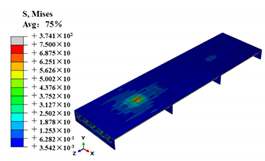 | 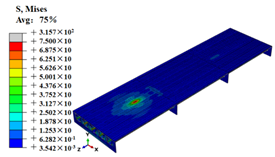 |
| M2 |  | 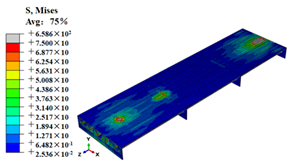 |
| M3 | 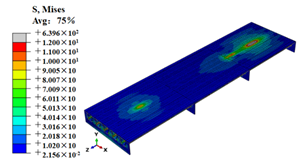 |  |
| M4 |  | 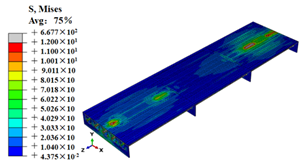 |
| M5 |  | 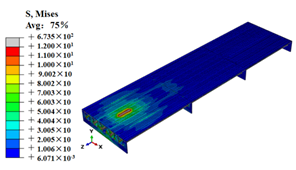 |
| M6 | 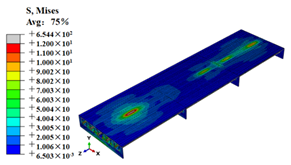 | 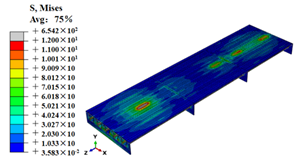 |
References
- Huang, Y.; Zhang, Q.; Bao, Y.; Bu, Y. Fatigue assessment of longitudinal rib-to-crossbeam welded joints in orthotropic steel bridge decks. J. Constr. Steel Res. 2019, 159, 53–66. [Google Scholar] [CrossRef]
- Zhang, X.; You, Y.C.; Kong, D.R.; Chen, T.; Zhang, J.R. An analytical investigation into the vibration behavior of an orthotropic steel deck. J. Vib. Control 2022, 5, 6. [Google Scholar] [CrossRef]
- Siwowski, T.; Kulpa, M.; Janas, L. Remaining Fatigue Life Prediction of Welded Details in an Orthotropic Steel Bridge Deck. J. Bridge Eng. 2019, 12, 05019013. [Google Scholar] [CrossRef]
- Kainuma, S.; Young, J.S.; Yang, M.; Inokuchi, S. Welding residual stress in roots between deck plate and U-rib in orthotropic steel decks. Measurement 2016, 92, 475–482. [Google Scholar] [CrossRef]
- Fang, H.; Iqbal, N.; Van Staen, G.; De Backer, H. Experimental and Numerical Investigation of Stress Concentration atRib-to-Crossbeam Joint. Int. J. Steel Struct. 2021, 21, 360–380. [Google Scholar] [CrossRef]
- Zeng, Z. Classification and cause analysis of typical fatigue cracks in orthotropic steel bridge panels. Steel Struct. 2011, 26, 9–15+26. (In Chinese) [Google Scholar]
- Su, Q.; Xie, H. Summary of steel structure bridge construction of Hong Kong-Zhuhai-Macao Bridge. China J. Highw. Trans. 2016, 29, 1–9. (In Chinese) [Google Scholar] [CrossRef]
- Di, J.; Ruan, X.Z.; Zhou, X.H.; Wang, J.; Peng, X. Fatigue assessment of orthotropic steel bridge decks based on strain monitoring data. Eng. Struct. 2021, 228, 111437. [Google Scholar] [CrossRef]
- Cui, C.; Zhang, Q.; Luo, Y.; Hao, H.; Li, J. Fatigue reliability evaluation of deck-to-rib welded joints in OSD considering stochastic traffic load and welding residual stress. Int. J. Fatigue 2018, 111, 151–160. [Google Scholar] [CrossRef]
- Xiang, C.; Wang, D.L.; Wang, B.J.; Chen, A.R.; Ma, R.J. Numerical simulation of root-deck crack propagation of orthotropic steel bridge deck. Struct. Infrastruct. Eng. 2022, 18, 1076–1090. [Google Scholar] [CrossRef]
- Zhang, Q.H.; Li, J.; Guo, Y.W.; Yuan, D.Y.; Bu, Y.Z. Fatigue failure modes and resistance evaluation of orthotropic steel bridge panel structures. China Civ. Eng. J. 2019, 52, 71–81. (In Chinese) [Google Scholar]
- Li, D.T.; Zhang, C.G.; Lu, P.M. Fatigue Property and Improvement of a Rounded Welding Region between the Diaphragm Plate and Closed Rib of an Orthotropic Steel Bridge Deck. Metals 2020, 1, 161. [Google Scholar] [CrossRef]
- Gou, H.; Shi, X.; Zhou, W.; Cui, K.; Pu, Q. Dynamic performance of continuous railway bridges: Numerical analyses and field tests. Proc. Inst. Mech. Eng. Part F J. Rail Rapid Transit 2018, 232, 936–955. [Google Scholar] [CrossRef]
- Chen, Y.X.; Lv, P.M.; Li, D.T. Research on Fatigue Strength for Weld Structure Details of Deck with U-rib and Diaphragm in Orthotropic Steel Bridge Deck. Metals 2020, 9, 484. [Google Scholar] [CrossRef]
- Bu, Y.Z.; Jin, Z.K.; Huang, Y.; Zhang, H.; Xu, G.Y. Key Influencing factors of Fatigue Crack Propagation in Longitudinal Rib Roof of Steel Bridge Panel. China J. Highw. Transp. 2019, 32, 61–70. (In Chinese) [Google Scholar]
- Jiang, C.; Long, X.Y.; Han, X.; Liu, J. A Method for Crack Growth Path Analysis of Random Crack Structures. Chin. J. Solid Mech. 2014, 35, 30–38. (In Chinese) [Google Scholar]
- Maljaars, J.; Bonet, E.; Pijpers, R.J.M. Fatigue resistance of the deck plate in steel orthotropic deck structures. Eng. Fract. Mech. 2018, 201, 214–228. [Google Scholar] [CrossRef]
- Maliaars, J.; Steenbergen, H.M.G.M.; Vrouwenvelder, A.C.W.M. Probabilistic Model for Fatigue Crack Growth and Fracture of Welded Joints in Civil Engineering Structures. Int. J. Fatigue 2012, 38, 108–117. [Google Scholar] [CrossRef]
- Xiao, Z.; Yamada, K.; Ya, S.; Zhao, X. Stress analyses and fatigue evaluation of rib-to-deck joints in steel orthotropic decks. Int. J. Fatigue 2008, 30, 1387–1397. [Google Scholar] [CrossRef]
- Yu, B.; Qiu, H.; Wang, H.; Guo, T. Experimental research on fatigue behavior and damage development of welded conformation of orthotropic steel bridge deck. J. Highw. Transp. Res. Dev. 2009, 26, 64–69. [Google Scholar] [CrossRef]
- Guo, J.; Hang, D.; Zhu, X. Prediction of Crack Propagation in U-Rib Components Based on the Markov Chain. J. Bridge Eng. 2020, 25, 04020089. [Google Scholar] [CrossRef]
- Heng, J.; Zheng, K.; Gou, C.; Zhang, Y.; Bao, Y. Fatigue performance of rib-to-deck joints in orthotropic steel decks with thickened edge U-ribs. J. Bridge Eng. 2017, 22, 04017059. [Google Scholar] [CrossRef]
- Hu, H.; Zhao, J.; Ren, Y.; An, L.; Liu, Y. Overall design of main bridge of mingzhu bay bridge. Bridge Constr. 2021, 51, 93–99. (In Chinese) [Google Scholar]
- Van den Berg, N.; Xin, H.; Veljkovic, M. Effects of residual stresses on fatigue crack propagation of an orthotropic steel bridge deck. Mater. Des. 2021, 198, 109294. [Google Scholar] [CrossRef]
- Xu, W.; Zhu, Z.; Niu, H. Study on Fatigue Cracking of Longitudinal rib-panel Reinforced with CFRP for orthotropic Steel Bridge Panels. J. Railw. Sci. Eng. 2021, 18, 2933–2943. (In Chinese) [Google Scholar]
- GB/T 714-2015; Bridge Structural Steel. National Standards of the People’s Republic of China: Beijing, China, 2015.
- Liu, P.; Chen, Y.; Lu, H.; Zhao, J.; An, L.; Wang, Y.; Liu, J. Fatigue Analysis of Long-Span Steel Truss Arched Bridge Part I: Experimental and Numerical Study of Orthotropic Steel Deck. Metals 2022, 12, 1117. [Google Scholar] [CrossRef]
- Liu, P.; Lu, H.; Chen, Y.; Zhao, J.; An, L.; Wang, Y.; Liu, J. Fatigue Analysis of Long-Span Steel Truss Arched Bridge Part II: Fatigue Life Assessment of Suspenders Subjected to Dynamic Overloaded Moving Vehicles. Metals 2022, 12, 1035. [Google Scholar] [CrossRef]
- Chen, Y.; Lv, P.; Li, D. Study on detail fatigue strength of welded structure between U rib and diaphragm. Bridge Constr. 2014, 44, 63–68. (In Chinese) [Google Scholar]
- Geng, X.; Yang, A. Influence factors of Residual Stress at U-rib Welding of Steel Bridge Panel. J. Railw. Sci. Eng. 2022, 45, 56–60. (In Chinese) [Google Scholar]
- Hobbacher, A. Recommendations for Fatigue Design of Welded Joints and Components IIW Doc, 2nd ed.; IIW 2259-15; Springer: Berlin/Heidelberg, Germany, 2016. [Google Scholar]
- Ye, X.; Su, Y.; Han, J. A State-of-the-Art Review on Fatigue Life Assessment of Steel Bridge. Math Probl. Eng. Vol. 2014, 2014, 956473. [Google Scholar] [CrossRef]
- Luo, P.; Zhang, Q.; Bao, Y.; Bu, Y. Fatigue performance of welded joint between thickened edge U-rib and deck in orthotropic steel deck. Eng. Struct. 2019, 181, 699–710. [Google Scholar] [CrossRef]
- Irwin, G.R.; Liebowitz, H.; Paris, P.C. A mystery of fracture mechanics. Eng. Fract. Mech. 1968, 1, 235–236. [Google Scholar] [CrossRef]
- Lee, Y.L.; Tjhung, T. Rainflow Cycle Counting Techniques. Met. Fatigue Anal. Handb. 2012, 89–114. [Google Scholar] [CrossRef]
- Zhang, Y.; Li, Y.; Zhang, D. Fatigue Life Estimation of Rib-to-Deck Joints in Orthotropic Steel Decks. Adv. Mat. Res. 2011, 163–167, 410–416. [Google Scholar] [CrossRef]
- JTG D64-2015; Code for Design of Highway Steel Structure Bridges. National Standards of the People’s Republic of China: Beijing, China, 2015.
- BS7910; Guide on Methods for Assessing the Acceptability of Flaws in Metallic Structures. British Standard Institution: London, UK, 2013.
- Radaj, D.; Sonsino, C.M.; Fricke, W. Fatigue Assessment of Welded Joints by Local Approaches; Woodhead Publishing: Cambridge, UK, 2006. [Google Scholar]
- Sedlacek, G.; Stranghoner, N.; Kuhn, B.; Hoffmeister, B.; Dahl, P.; Langenberg, P.; Kalinowski, B.; Bleck, W.; Mannsfeld, A.; Brozetti, J.; et al. Composite Bridge Design Improvement for High-Speed Railways; Office for Official Publications of the Europen Cmmunities: Luxembourg, 2001. [Google Scholar]
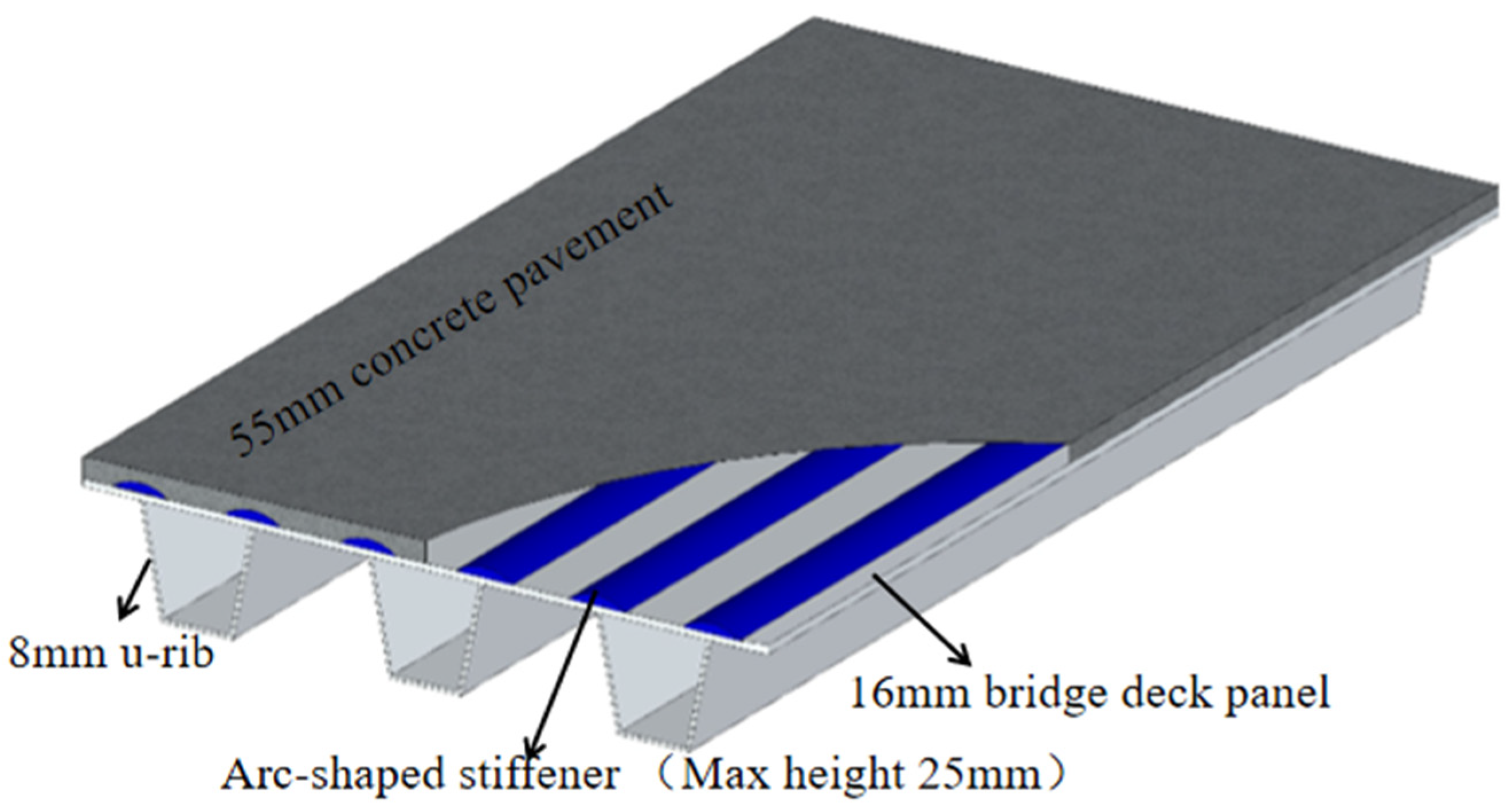
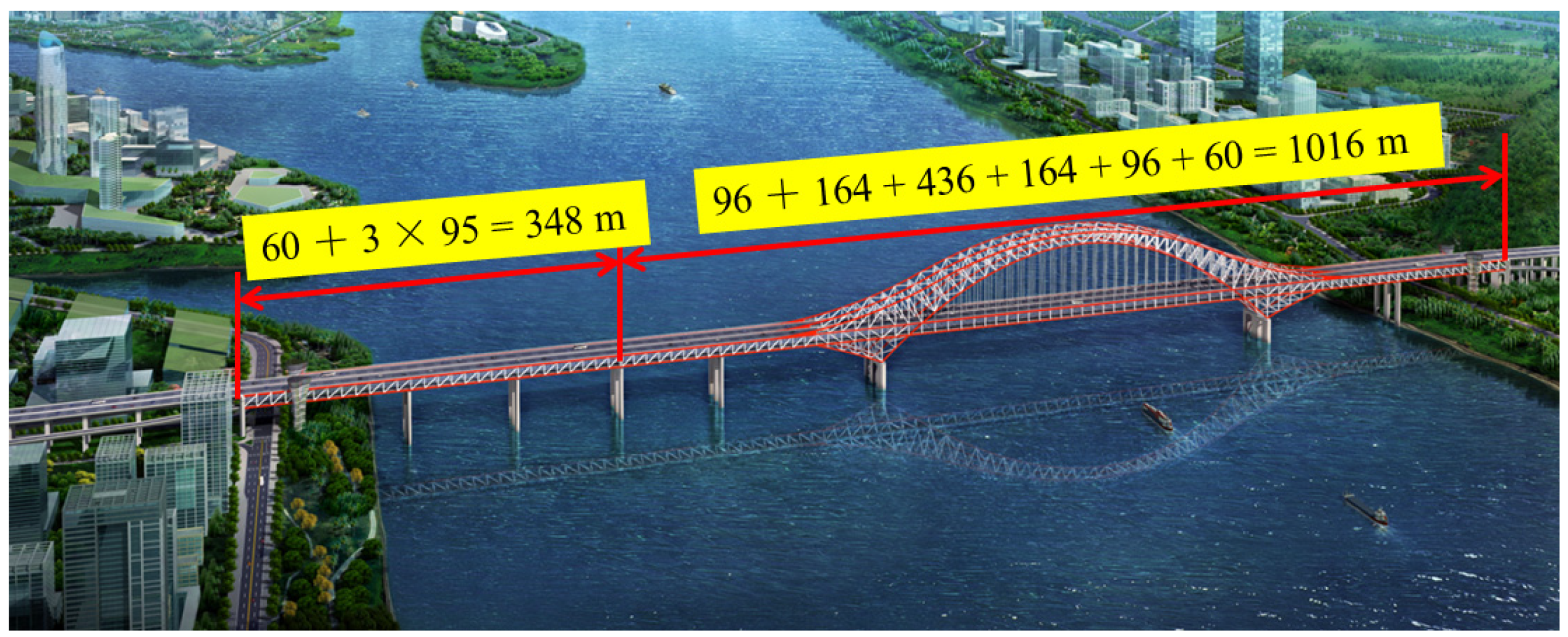
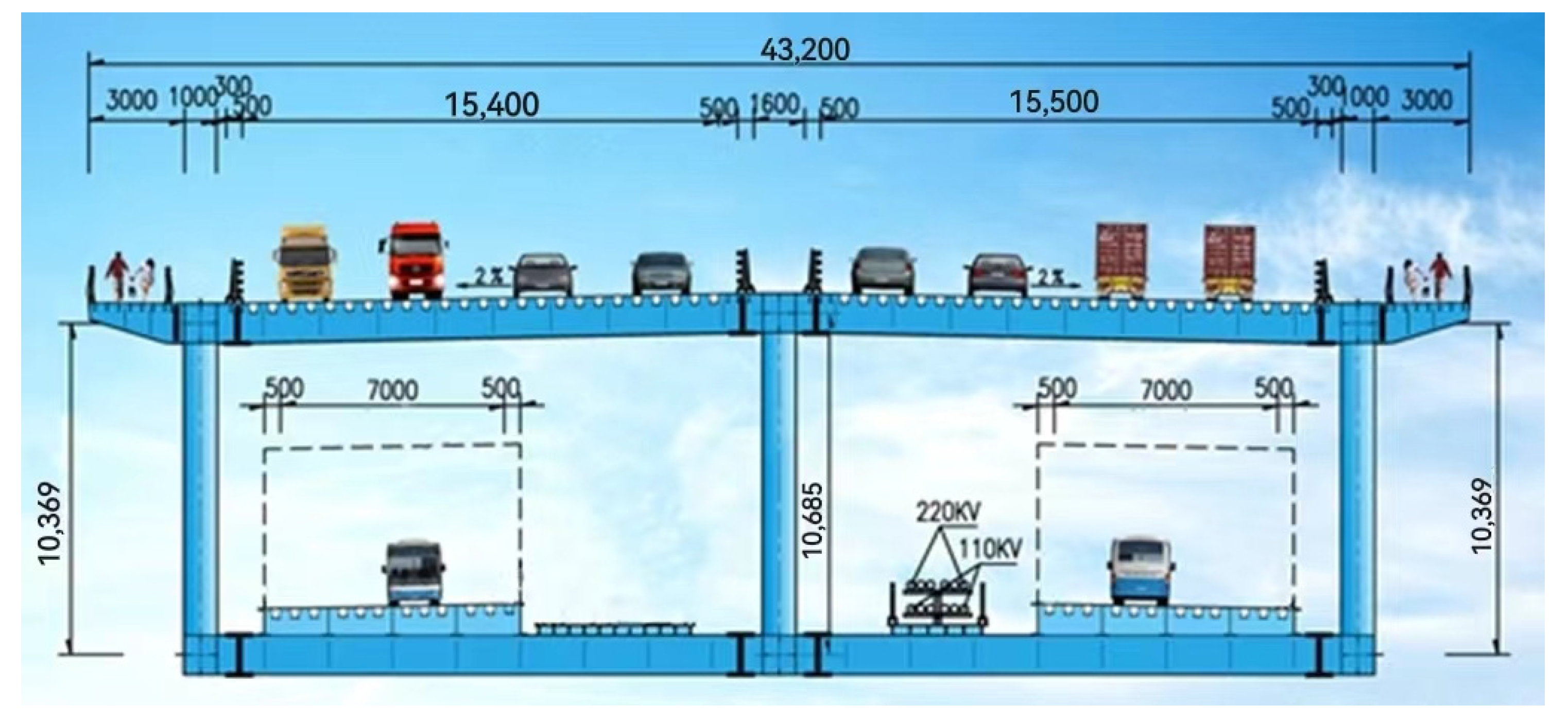
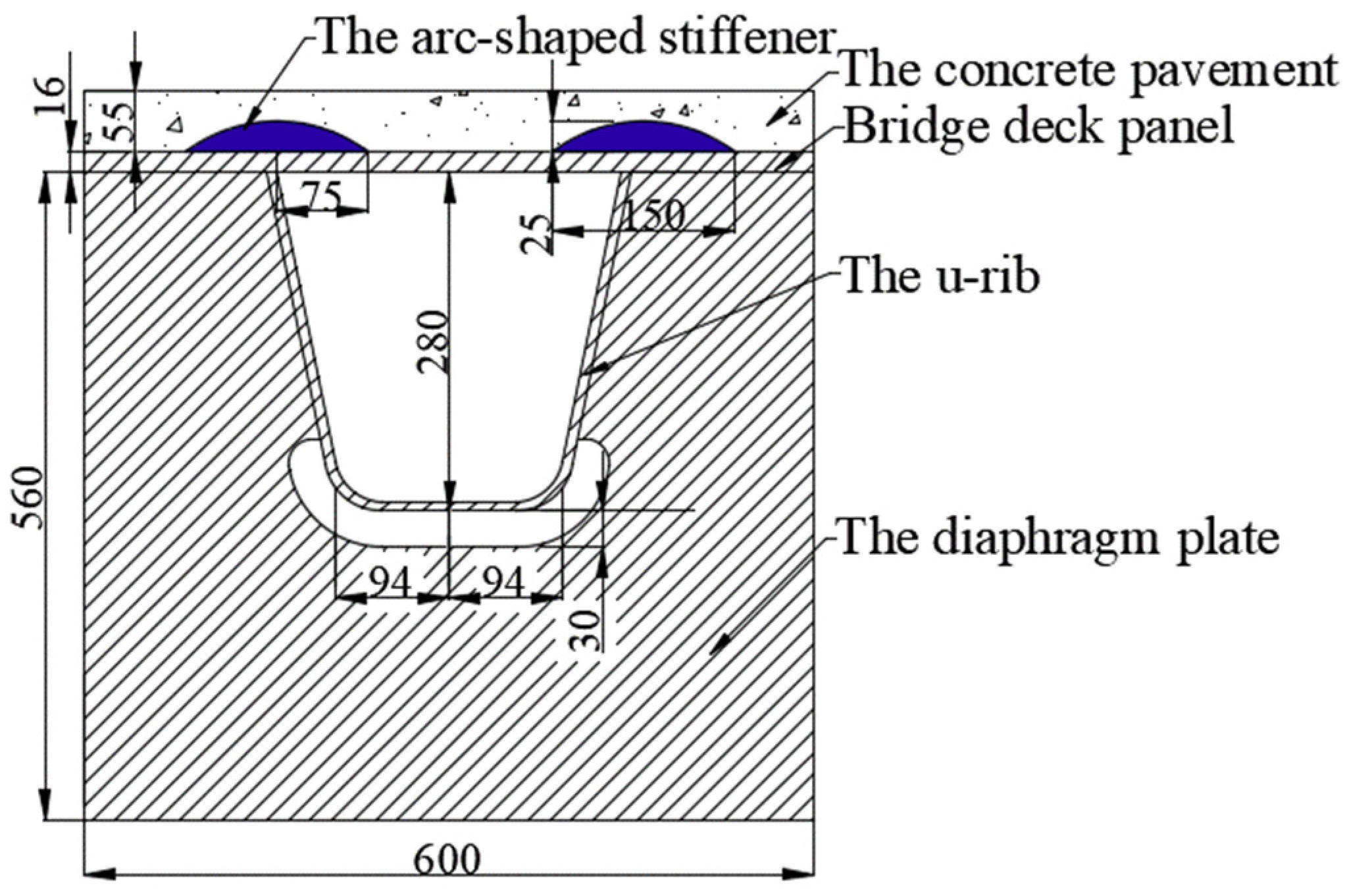
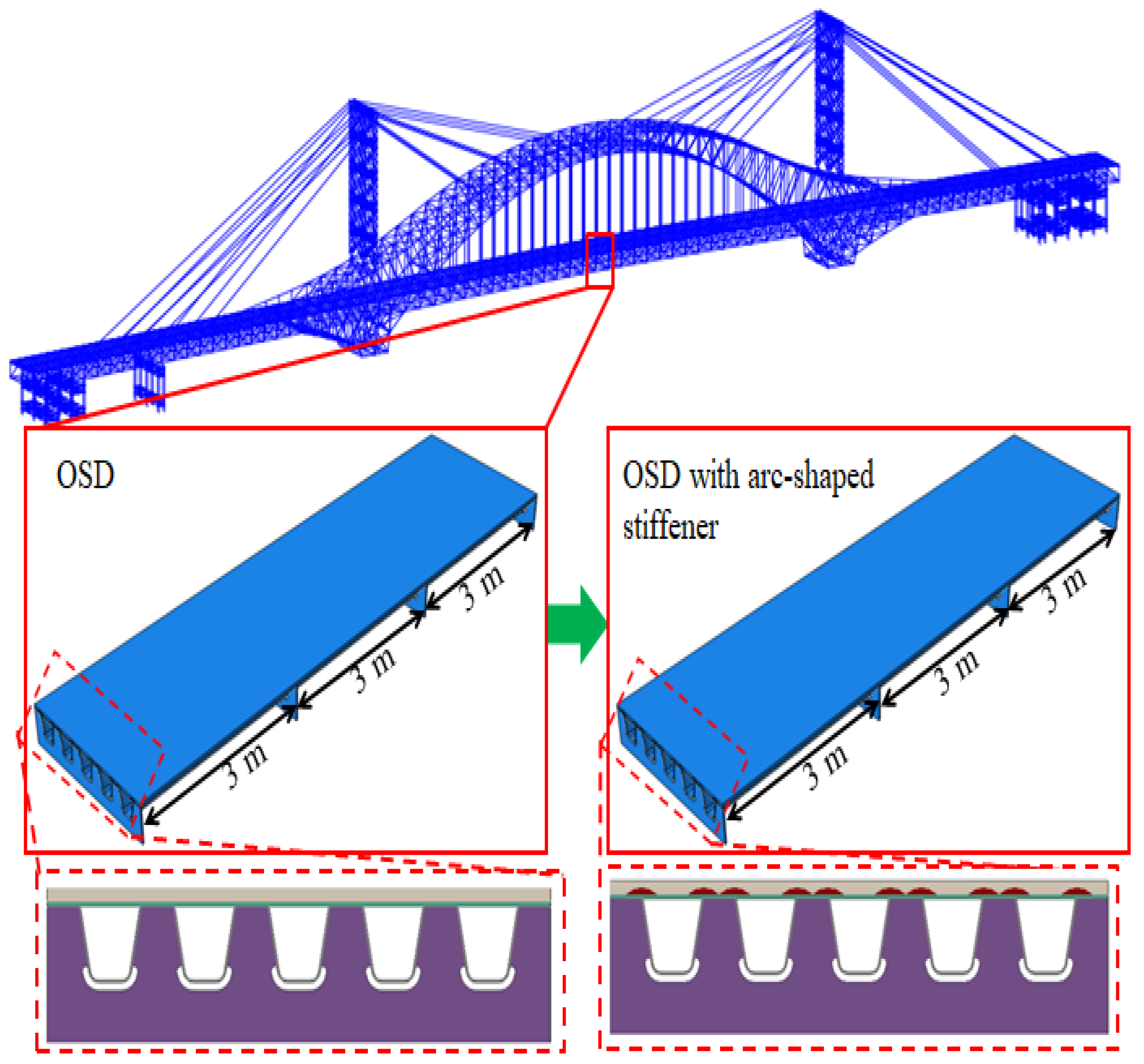
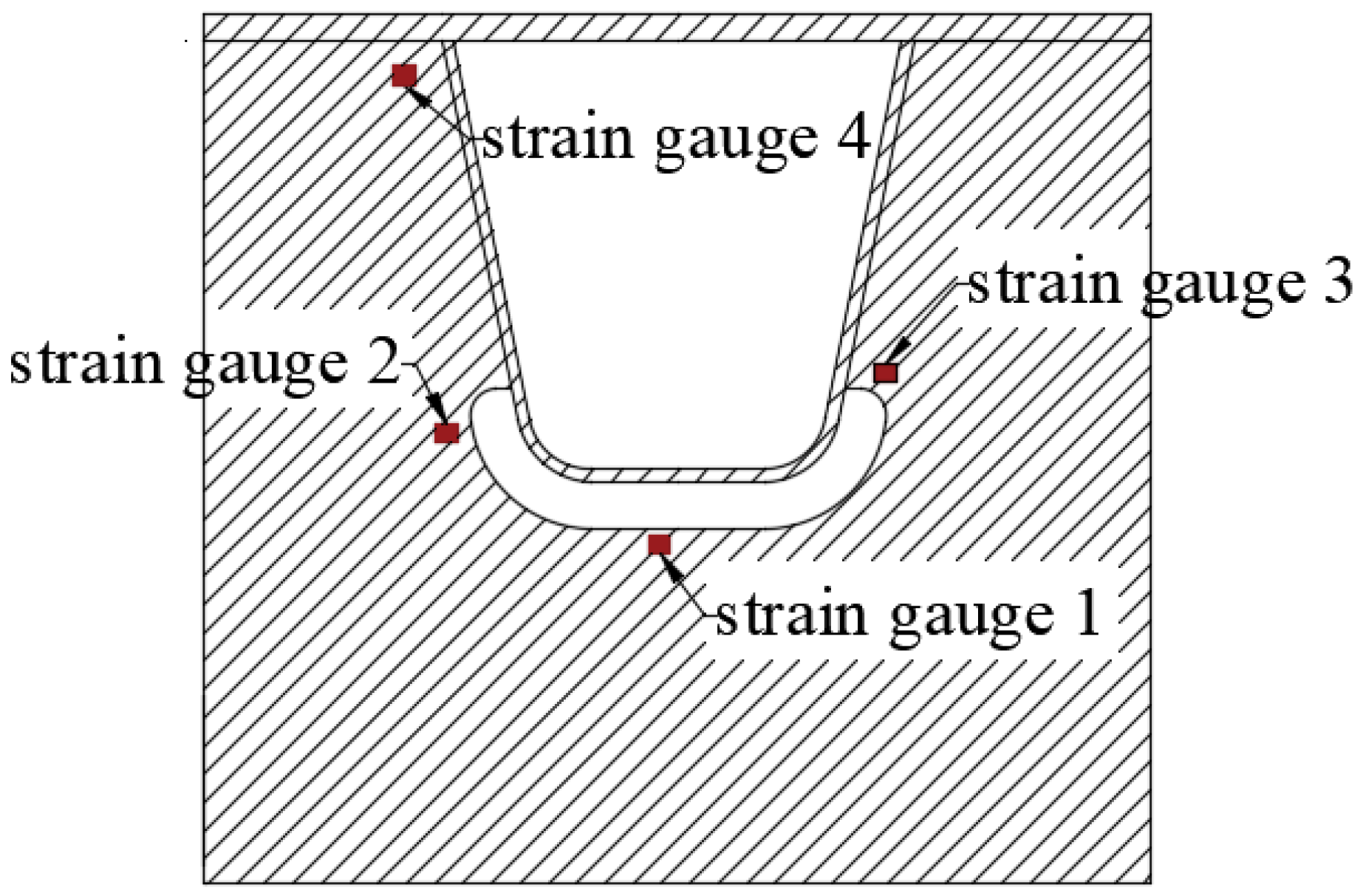
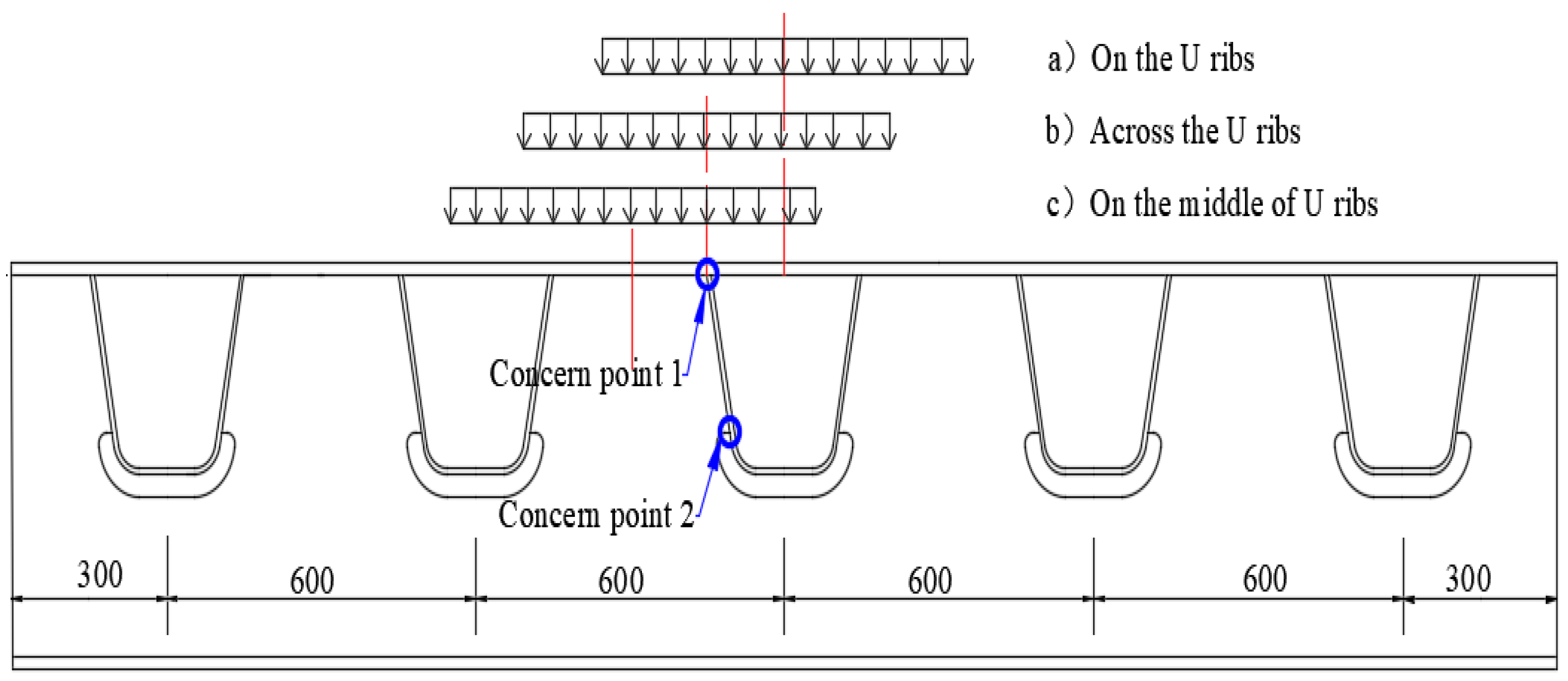

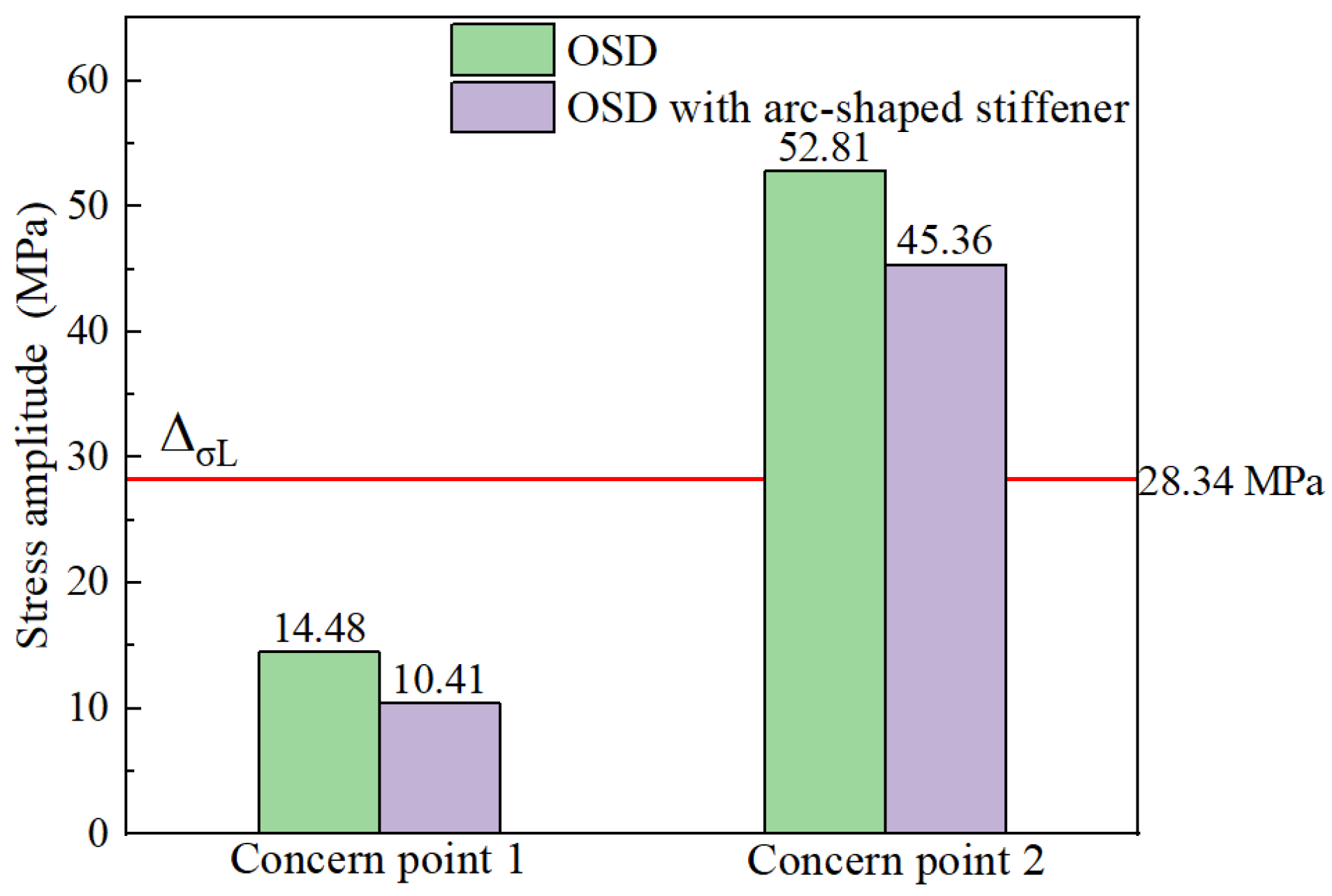
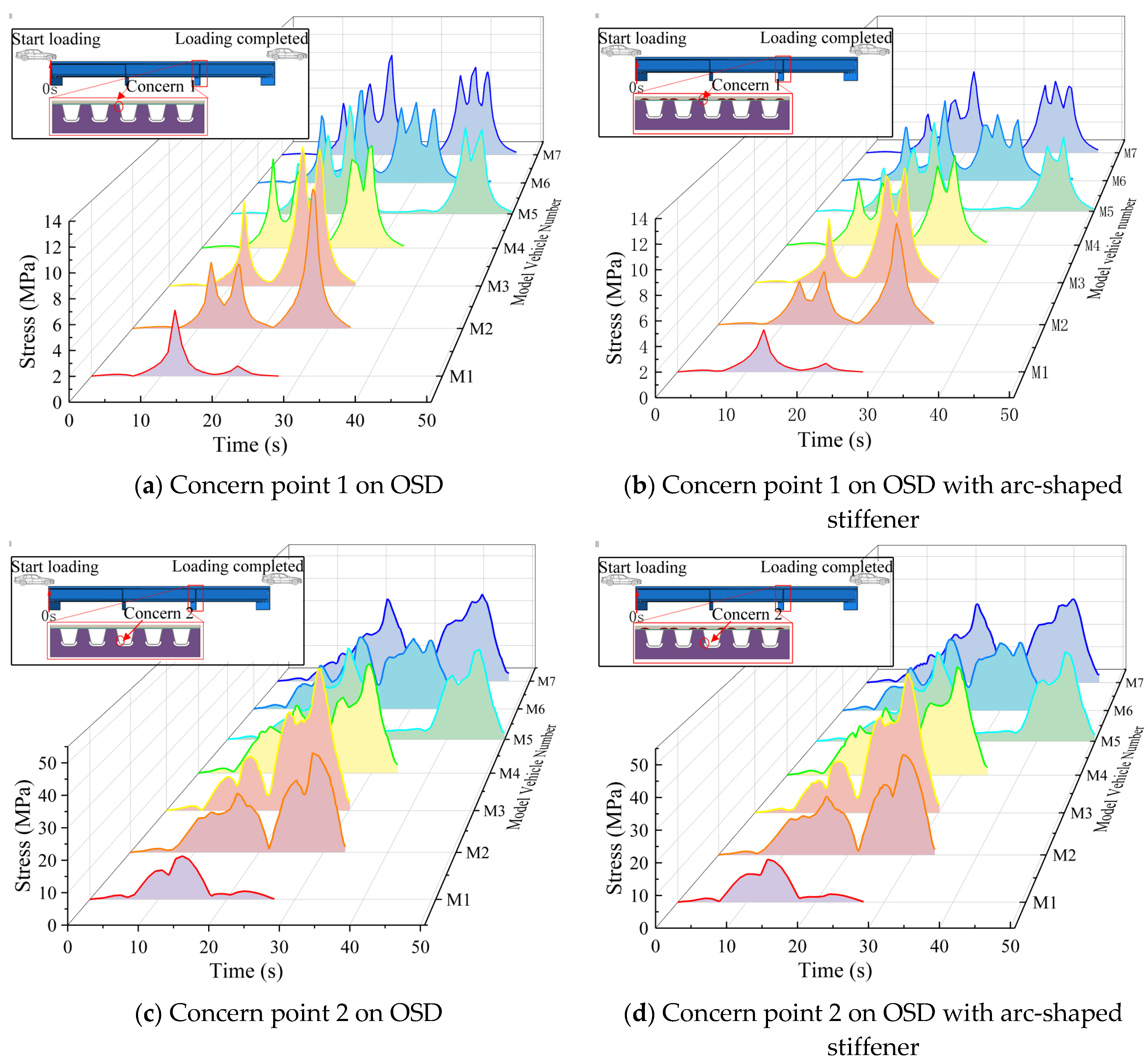
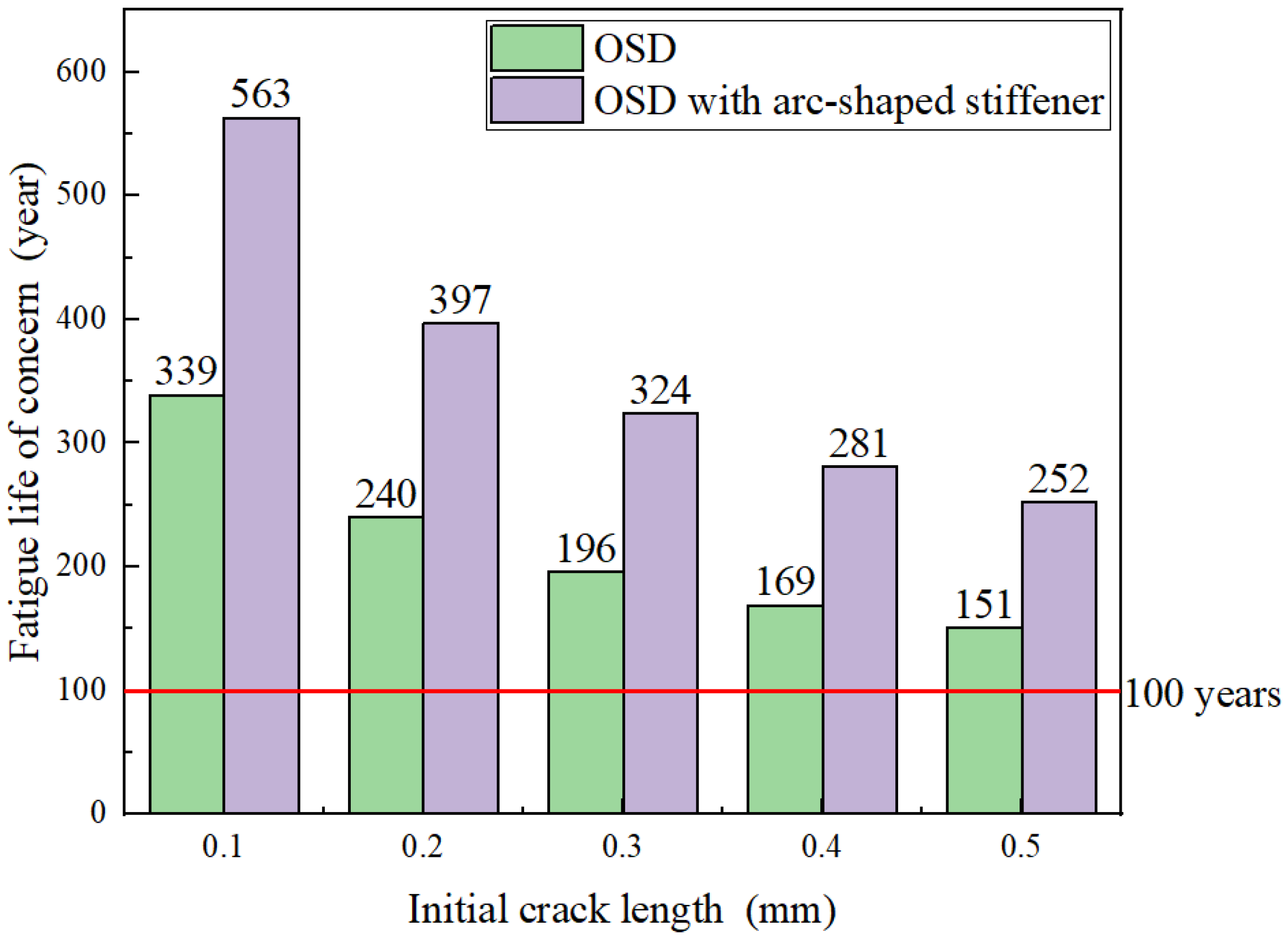
| C | Si | Mn | P | S | Als | Nb | V | Ti | N |
|---|---|---|---|---|---|---|---|---|---|
| ≤0.14 | ≤0.55 | 1.00–1.60 | ≤0.020 | ≤0.010 | 0.010–0.045 | 0.010–0.090 | 0.010–0.080 | 0.006–0.030 | ≤0.0080 |
| Thickness (mm) | Yield Strength (MPa) | Tensile Strength (MPa) | Elongation after Fracture (%) |
|---|---|---|---|
| ≤50 50–100 | ≥370 ≥360 | ≥510 | 20 |
| Strain Gauge 1 | Strain Gauge 2 | Strain Gauge 3 | Strain Gauge 4 | |||||
|---|---|---|---|---|---|---|---|---|
| Test | FEM | Test | FEM | Test | FEM | Test | FEM | |
| Stress | 128.5 | 124.8 | 132.1 | 140.8 | 128.1 | 117.4 | 135.5 | 137.91 |
| Deviation | 2.5% | 6.7% | 8.3% | 1.8% | ||||
| Vehicle Model Type | Axle | Vehicle Model (Axle Weight, kN, Axle Spacing, mm) | Total Weight (kN) | The Proportion of Total Traffic | Daily Traffic Flow |
|---|---|---|---|---|---|
| M1 | 2 |  | 135 | 14.78 | 1543 |
| M2 | 3 |  | 222 | 2.14 | 223 |
| M3 | 3 |  | 286 | 0.7 | 73 |
| M4 | 4 |  | 319 | 4.14 | 460 |
| M5 | 5 |  | 389 | 0.13 | 13 |
| M6 | 5 |  | 387 | 1.29 | 135 |
| M7 | 6 |  | 468 | 13.92 | 1453 |
| Stress Range ∆σ Classification/MPa | Number of Cycles Recorded | |||
|---|---|---|---|---|
| Concern Point 1 | Concern Point 2 | |||
| OSD | OSD with Arc-Shaped Stiffener | OSD | OSD with Arc-Shaped Stiffener | |
| 0–5 | 15,302 | 24,387 | 23,634 | 31,016 |
| 5–10 | 4418 | 3246 | 493 | 270 |
| 10–15 | 73 | 1762 | 1616 | 1616 |
| 15–20 | 0 | 0 | 358 | 358 |
| 20–25 | 0 | 0 | 683 | 460 |
| 25–30 | 0 | 0 | 135 | 135 |
| 30–35 | 0 | 0 | 1689 | 1689 |
| 35–40 | 0 | 0 | 1466 | 1466 |
| 40–45 | 0 | 0 | 460 | 460 |
| 45–50 | 0 | 0 | 0 | 73 |
| 50–55 | 0 | 0 | 73 | 0 |
| Bridge Panel Type | OSD | OSD with Arc-Shaped Stiffener |
|---|---|---|
| 4506 | 4283 | |
| 30.35 | 30.66 |
| Initial Crack Length (mm) | The Fatigue Life of Concern (Year) | |
|---|---|---|
| OSD | OSD with Arc-Shaped Stiffener | |
| 0.1 | 339 | 563 |
| 0.2 | 240 | 397 |
| 0.3 | 196 | 324 |
| 0.4 | 169 | 281 |
| 0.5 | 151 | 252 |
Publisher’s Note: MDPI stays neutral with regard to jurisdictional claims in published maps and institutional affiliations. |
© 2022 by the authors. Licensee MDPI, Basel, Switzerland. This article is an open access article distributed under the terms and conditions of the Creative Commons Attribution (CC BY) license (https://creativecommons.org/licenses/by/4.0/).
Share and Cite
Liu, P.; Chen, Y.; Lu, H.; Zhao, J.; An, L.; Wang, Y. Fatigue Resistance Analysis of the Orthotropic Steel Deck with Arc-Shaped Stiffener. Metals 2022, 12, 1739. https://doi.org/10.3390/met12101739
Liu P, Chen Y, Lu H, Zhao J, An L, Wang Y. Fatigue Resistance Analysis of the Orthotropic Steel Deck with Arc-Shaped Stiffener. Metals. 2022; 12(10):1739. https://doi.org/10.3390/met12101739
Chicago/Turabian StyleLiu, Peng, Yixuan Chen, Hongping Lu, Jian Zhao, Luming An, and Yuanqing Wang. 2022. "Fatigue Resistance Analysis of the Orthotropic Steel Deck with Arc-Shaped Stiffener" Metals 12, no. 10: 1739. https://doi.org/10.3390/met12101739
APA StyleLiu, P., Chen, Y., Lu, H., Zhao, J., An, L., & Wang, Y. (2022). Fatigue Resistance Analysis of the Orthotropic Steel Deck with Arc-Shaped Stiffener. Metals, 12(10), 1739. https://doi.org/10.3390/met12101739






